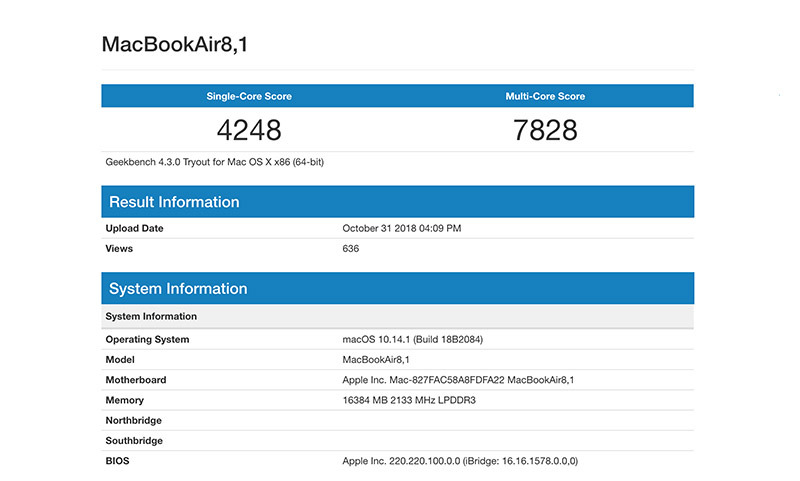Results posted to benchmarking service Geekbench this week purportedly show Apple's new MacBook Air outperforming last year's 12-inch MacBook with Intel Core i5 processor, but falling short of the same model equipped with a Core i7 CPU.
If numbers from Geekbench 4, posted to the service's Geekbench Browser on Wednesday, are legitimate, Apple's new thin-and-light is indeed powered by Intel's new Core i5-8210Y.
The chip was officially announced through Intel's ARK database this week shortly after Apple unveiled its MacBook Air refresh. Specifications provided by Intel and Apple detail a 1.6GHz dual-core Intel Core i5 processor with Turbo Boost up to 3.6GHz, 4MB of L3 cache, support for up to 16GB of 2133MHz LPDDR3 memory and integrated UHD Graphics 617.
Performance metrics for the Y-series silicon have been unavailable, as the CPU remained under wraps until the MacBook Air reveal.
According to Geekbench, Apple's new Air clocks in with a single-core score of 4,248 and a multi-core score of 7,828. The single-core performance is roughly equivalent to an aggregate of scores reported for the 2017 12-inch MacBook with Core i7 clocked at 1.4GHz. MacBook Air's multi-core scores fall expectedly short of the i7, but are higher than those put in by Core i5 MacBooks.
Existing MacBook models rely on 7th generation Core i5 and i7 Kaby Lake technology — or Core m for base configurations — while the MacBook Air's i5 is an 8th generation Amber Lake chip. Both families are built on Intel's 14-nanometer process.
Apple is trading performance potential for efficiency by opting for Amber Lake, though the newly designed CPU and integrated GPU pairing is a step up from the Broadwell architecture currently used by the non-Retina display MacBook Air. Apple's 2015 MacBook Air models relied on 5th generation Intel Core i5 and i7 U-series processors.
Interestingly, Apple has opted to incorporate an "active cooling system" — a fan — in the latest MacBook Air iteration despite the Y-series' low 7 watt TDP. By comparison, the previous Air's Broadwell chips ran at 15W, configurable down to 9.5W.
 Mikey Campbell
Mikey Campbell







-m.jpg)






 Charles Martin
Charles Martin

 Malcolm Owen
Malcolm Owen
 William Gallagher
William Gallagher

 Christine McKee
Christine McKee
 Wesley Hilliard
Wesley Hilliard








49 Comments
The new Macbook Air is not very compelling honestly. As the Zone of Tech guy pointed out, it's only a little bit more for the 13" Macbook Pro which is better on nearly every metric.
I often find myself wishing for a technical expose of Apple design decisions... Is trading retina graphics for i7 multicore speeds applicable here, and then perhaps a BTO option (same bezel lower res) for those who might prefer the reverse...?
Apple's new MacBook Air is their entry level notebook for the next 5 years. After that they will drop it for the MacBook form factor.
After that the MacBook will be the first touch screen Apple NoteBook.
Over time, the Air's price will come down and the specs will go up.
Basically, like the iPad, the goal is to get off the 'every year redesign crazy train!'
It's a very strong offering, with a smaller form factor, Touch ID, improved trackpad and a Retina display.
Unfortunately, it's the Retina display that has made the price over the $1,000 price point. But they had do it!
As far as the MacBook...it can still remain in the lineup as a premium device focusing on being the ultimate in a portability device (that isn't an iPad). .75 pounds less than the new MacBook Air is a lot.
Next year, the MacBook could have the upgraded trackpad, TouchID, be a little lighter, less bezel around the screen, another port or two and faster processors.
I paid a little more for my rose gold 2017 MacBook most importantly for the two pounds. I would do it again. :)
Wasn't the passive airflow through the keyboard with previous models? If so, wouldn't that now be inhibited by these new keyboards with silicon dirt and crumb protector, which may be why a fan is now required?
They should have unveiled a new MacBook Air with a Liquid Retina display (rounded corners). That would have made all the difference.